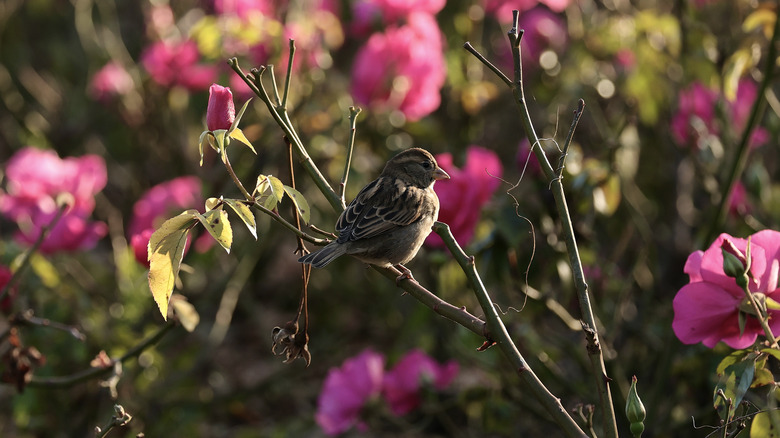Attract Beautiful Birds With These Rose Variety Plants
While bright flowers and lush foliage can create a beautiful garden, nothing quite brings the landscape to life like seeing birds flitter from bush to bush, singing to each other, or hunting for bugs among your shrubs. But they're not just fun to watch; birds are also some of your best allies in the fight against common garden pests. Smaller species are voracious eaters of aphids and other insect pests, while larger species like owls and hawks gladly help you keep your rodent population under control. If you're hoping to attract more songbirds to your garden, many rose varieties provide a mix of food and shelter that your local birds need. Native roses, like swamp rose or prairie wild rose, are low-maintenance and attract dozens of bird species. These roses form thorny thickets or shrubs that smaller birds use to hide from predators. Come fall, they produce nutritious rose hips, a type of fruit that can supplement a bird's diet as the weather cools and insect populations drop ahead of winter.
Meanwhile, non-native shrub roses and climbing roses can still provide shelter to the bird visitors in your garden. So, if you prefer the more cultivated look of non-native roses, cultivars like cabbage rose or damask rose can still provide some habitat value to birds. But you don't have to choose one over the other. You can create a gorgeous rose garden that seamlessly weaves native and non-native rose varieties together for a vibrant floral display you'll love and a prime habitat for local birds.
Native roses that attract birds to your garden
The best rose varieties to add to your garden if you want to attract birds are native species. There are dozens of rose varieties that are native throughout the United States. Though, you're more likely to find cultivated shrub roses, like the popular Knock Out variety, in most gardens. In addition to attracting birds to your garden, these native roses also tend to be much easier to grow.
Some of the most valuable native varieties for birds include swamp rose (Rosa palustris), prairie rose (Rosa arkansana), meadow rose (Rosa blanda), and pasture rose (Rosa carolina). All of these provide rose hips that can help keep birds nourished through the winter. These and other native roses are also an important source of pollen for native bees and serve as host plants for the caterpillars of about 100 species of butterflies and moths.
The blooms on native roses typically aren't as fluffy as traditional cultivated roses. Most native rose varieties have blooms similar in shape to the multiflora rose, an invasive weed you'll want to avoid growing in North America. Still, they usually have large, showy flowers that are later replaced by bright, typically red rose hips that provide winter interest (and, as mentioned, food for birds). Depending on species, you can plant native roses as a hedge, as trailing ground cover, or to add year-round interest to a flower bed.
Tips for growing non-native roses for birds
While non-native roses don't typically provide much nectar or pollen for native bees, they can still provide bird habitat. Those with dense, thorny branches like cabbage roses (Rosa centifolia) or damask roses (Rosa x damascena) can still be used as shelter for birds. Rambling roses like cultivars of the memorial rose (Rosa lucieae) also offer good shelter for birds. While most modern cultivars, like hybrid tea roses or the popular floribunda and grandiflora cultivars, have been bred for large, repeat blooms at the expense of developing good rose hips, you can still find cultivars that produce edible rose hips birds can eat.
Then, create a mixed bed of your favorite native and non-native roses. For example, fill a trellis or create a wall of blooms using a mix of cultivated memorial roses and native climbing prairie roses (Rosa setigera). Alternatively, add privacy to your backyard with a mixed flowering hedge of damask roses and thicket-forming native roses like Nootka rose (Rosa nutkana) or Wood's wild rose (Rosa woodsii).
When shopping for non-natives, be sure to avoid aggressive non-natives like the multiflora rose (Rosa multiflora) mentioned earlier as well as dog roses (Rosa canina) and sweetbriar roses (Rosa rubiginosa). These invasive species quickly take over gardens, outcompeting natives and even your more well-behaved non-native roses. Plus, you can get similar-looking blooms in just about any native rose variety mentioned earlier.


